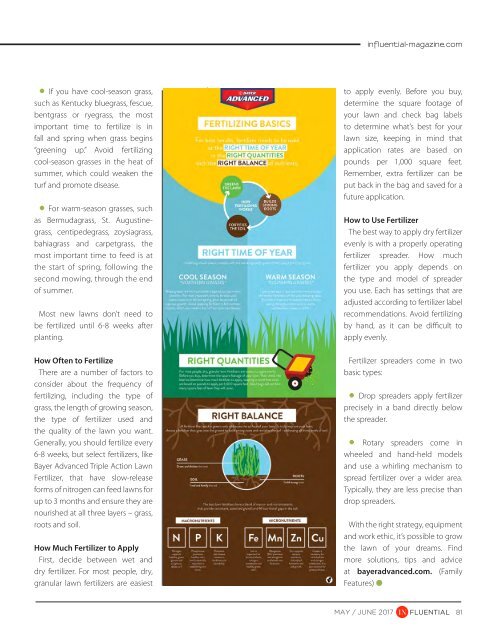InFluential_Magazine_May_June_2017
You also want an ePaper? Increase the reach of your titles
YUMPU automatically turns print PDFs into web optimized ePapers that Google loves.
influential-magazine.com<br />
• If you have cool-season grass,<br />
such as Kentucky bluegrass, fescue,<br />
bentgrass or ryegrass, the most<br />
important time to fertilize is in<br />
fall and spring when grass begins<br />
“greening up.” Avoid fertilizing<br />
cool-season grasses in the heat of<br />
summer, which could weaken the<br />
turf and promote disease.<br />
• For warm-season grasses, such<br />
as Bermudagrass, St. Augustinegrass,<br />
centipedegrass, zoysiagrass,<br />
bahiagrass and carpetgrass, the<br />
most important time to feed is at<br />
the start of spring, following the<br />
second mowing, through the end<br />
of summer.<br />
Most new lawns don’t need to<br />
be fertilized until 6-8 weeks after<br />
planting.<br />
How Often to Fertilize<br />
There are a number of factors to<br />
consider about the frequency of<br />
fertilizing, including the type of<br />
grass, the length of growing season,<br />
the type of fertilizer used and<br />
the quality of the lawn you want.<br />
Generally, you should fertilize every<br />
6-8 weeks, but select fertilizers, like<br />
Bayer Advanced Triple Action Lawn<br />
Fertilizer, that have slow-release<br />
forms of nitrogen can feed lawns for<br />
up to 3 months and ensure they are<br />
nourished at all three layers – grass,<br />
roots and soil.<br />
How Much Fertilizer to Apply<br />
First, decide between wet and<br />
dry fertilizer. For most people, dry,<br />
granular lawn fertilizers are easiest<br />
to apply evenly. Before you buy,<br />
determine the square footage of<br />
your lawn and check bag labels<br />
to determine what’s best for your<br />
lawn size, keeping in mind that<br />
application rates are based on<br />
pounds per 1,000 square feet.<br />
Remember, extra fertilizer can be<br />
put back in the bag and saved for a<br />
future application.<br />
How to Use Fertilizer<br />
The best way to apply dry fertilizer<br />
evenly is with a properly operating<br />
fertilizer spreader. How much<br />
fertilizer you apply depends on<br />
the type and model of spreader<br />
you use. Each has settings that are<br />
adjusted according to fertilizer label<br />
recommendations. Avoid fertilizing<br />
by hand, as it can be difficult to<br />
apply evenly.<br />
Fertilizer spreaders come in two<br />
basic types:<br />
• Drop spreaders apply fertilizer<br />
precisely in a band directly below<br />
the spreader.<br />
• Rotary spreaders come in<br />
wheeled and hand-held models<br />
and use a whirling mechanism to<br />
spread fertilizer over a wider area.<br />
Typically, they are less precise than<br />
drop spreaders.<br />
With the right strategy, equipment<br />
and work ethic, it’s possible to grow<br />
the lawn of your dreams. Find<br />
more solutions, tips and advice<br />
at bayeradvanced.com. (Family<br />
Features) l<br />
MAY / JUNE <strong>2017</strong><br />
FLUENTIAL<br />
81


















